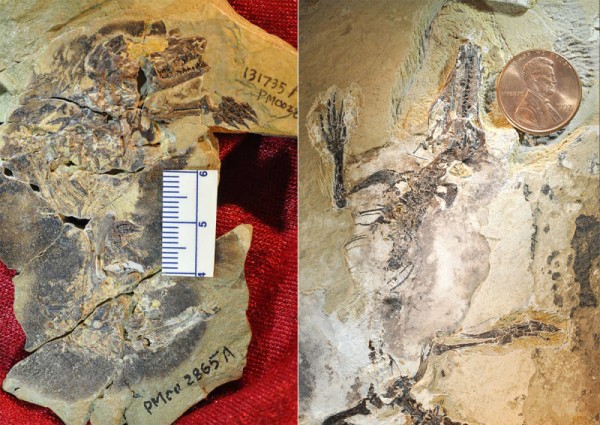Fossils of 2 Small Jurassic Mammals Found in China
| Ana Verayo | | Feb 13, 2015 05:17 AM EST |
(Photo : Zhe-Xi Luo/University of Chicago) Images of the fossils of Docofossor (left) and Agilodocodon (right).
Fossils of two new Jurassic mammals were found in China, one of which is a tree climber and the other a burrow dweller.
Paleontologists say these two animals reveal the biodiversity of mammals that began as early as 160 million years ago.
These fossils were originally uncovered in China. These animals are the size of two small shrew-size creatures classified as mammaliaformes that are extinct relatives of modern mammals.
Like Us on Facebook
The Agilodocodon scansorius has claws used for climbing trees. Its teeth have adapted to feed on tree sap. It's also the earliest known tree dwelling mammaliform, says scientists from the University of Chicago and Beijing Museum of Natural History.
The Docofossor brachydactylus is also the earliest known subterranean mammaliaform. It's similar to modern African golden moles that have paws used like a shovel for burrowing.
These fossils support the evidence of the global establishment of the mammal species. It reveals how they evolved early and rapidly and adapted to their new environment and ecosystem.
This also debunks assumptions about the stumped evolution and diversification of mammals during the Mesozoic era dominated by dinosaurs.
According to Zhe-Xi Luo a professor of organismal biology and anatomy from the University of Chicago, these new fossils reveal the earliest ancient mammals were apparently equally diverse in their feeding process and locomotor adaptations compared to modern mammals. The mammaliam success of the species was apparent long ago as it is today.
These fossil discoveries, among many others, are strong evidence of an early explosion of mammalian evolution that placed them on equal with as their dinosaur counterparts during the prehistoric era.
This also means dinosaurs weren't the only ones that dominated the Mesozoic landscapes as previously thought. These small mammals brought a large impact to ecological diversity that can be felt today.
Researchers say these Chinese mammal fossils also share a common ancestor with other extant mammals but apparently have no direct living descendants.
This study was published in the journal, Science
Tags2 New Small Jurassic Mammals Found in China, University of Chicago, jurassic mammals, two fossils jurassic mammals small tiny china
©2015 Chinatopix All rights reserved. Do not reproduce without permission
EDITOR'S PICKS
-

Did the Trump administration just announce plans for a trade war with ‘hostile’ China and Russia?
-

US Senate passes Taiwan travel bill slammed by China
-

As Yan Sihong’s family grieves, here are other Chinese students who went missing abroad. Some have never been found
-

Beijing blasts Western critics who ‘smear China’ with the term sharp power
-

China Envoy Seeks to Defuse Tensions With U.S. as a Trade War Brews
-

Singapore's Deputy PM Provides Bitcoin Vote of Confidence Amid China's Blanket Bans
-

China warns investors over risks in overseas virtual currency trading
-

Chinese government most trustworthy: survey
-

Kashima Antlers On Course For Back-To-Back Titles
MOST POPULAR
LATEST NEWS
Zhou Yongkang: China's Former Security Chief Sentenced to Life in Prison

China's former Chief of the Ministry of Public Security, Zhou Yongkang, has been given a life sentence after he was found guilty of abusing his office, bribery and deliberately ... Full Article
TRENDING STORY

China Pork Prices Expected to Stabilize As The Supplies Recover

Elephone P9000 Smartphone is now on Sale on Amazon India

There's a Big Chance Cliffhangers Won't Still Be Resolved When Grey's Anatomy Season 13 Returns

Supreme Court Ruled on Samsung vs Apple Dispute for Patent Infringement

Microsoft Surface Pro 5 Rumors and Release Date: What is the Latest?










